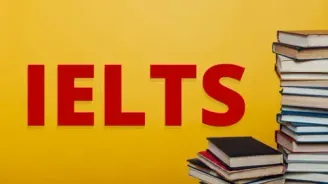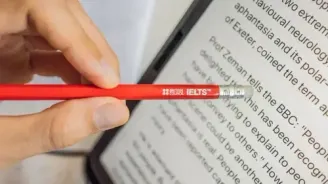List of IELTS Reading Answers in 2025
- Hybrid Solar Lighting Reading Answers
- When Conversations Flow Reading Answers
- Why Companies Should Welcome Disorder Reading Answers
- The Changing Role Of Airports Reading Answers
- Calisthenics Reading Answers
- Flawed Beauty Reading Answers
- Graffiti Reading Answers
- All About the Otter Reading Answers
- Forest Management In Pennsylvania USA Reading Answers
- The Meaning Of Volunteering Reading Answers
- Cosmetics in Ancient Past Reading Answers
- Jargon Reading Answers
- Urban Farming Reading Answers
- The Best Suitcases Reading Answers
- The History of Pencil Reading Answers
- William Henry Perkin Reading Answers
- Research Using Twins Reading Answers
- How Does the Biological Clock Tick Reading Answers
- Making Every Drop Count Reading Answers
- Artificial Artists Reading Answers
- Votes For Women Reading Answers
- This Marvellous Invention Reading Answers
- New Zealand Seaweed Reading Answers
- The Great Fire Of London Reading Answers
- Walking with Dinosaurs Reading Answers
- Telepathy Reading Answers
- The Vikings Wayfaring Ways Reading Answers
- The True Cost Of Food Reading Answers
- In Praise Of Amateurs Reading Answers
- Thomas Young Reading Answers
- Bring Back the Big Cats Reading Answers
- Coastal Archaeology Of Britain Reading Answers
- Glow Worms Reading Answers
- Tea And The Industrial Revolution Reading Answers
- The Development Of Museums Reading Answers
- What Do Whales Feel Reading Answers
- Biological Control of Pests Reading Answers
- Saving The British Bitterns Reading Answers
- The Mozart Effect Reading Answers
- Space Travel And Health Reading Answers
- The History Of Glass Reading Answers
- Airports On Water Reading Answers
- Lost For Words Reading Answers
- The Nature And Aims Of Archaeology Reading Answers
- A Chronicle Of Timekeeping Reading Answers
- Diabetes Reading Answers
- Freebie Marketing Reading Answers
- Bondi Beach Reading Answers
- Second Nature Reading Answers
- The Creation Myth Reading Answers
- Living Dunes Reading Answers
- Ocean Acidification Reading Answers
- The Stress of Relocation Reading Answers
- A Bar At The Folies Reading Answers
- The Intersection of Health Sciences and Geography Reading Answers
- Grey Workers Reading Answers
- The Power Of Nothing Reading Answers
- Survivor From The Sky Reading Answers
- Global Warming Reading Answers
- Highs and Lows Reading Answers
- Geoff Brash Reading Answers
- Scratching the Surface Reading Answers
- Alfred Nobel Reading Answers
- Saving Language Reading Answers
- Music Clubs Reading Answers
- Indoor Pollution Reading Answers
- Allergy Testing Reading Answers
- Metropolis Movies Reading Answers
- One Hundred Days Of Reform Reading Answers
- Poverty and Health Reading Answers
- Leisure Time Reading Answers
- The Luddites Reading Answers
- Cleaner Abundant Reading Answers
- Tomato Ripening Reading Answers
- Flight From Reality Reading Answers
- The Columbian Exchange Reading Answers
- Its Ecological Reading Answers
- Communicating In Colour Reading Answers
- Tea Times Reading Answers
- The Power Of Play Reading Answers
- The Flavour Of Pleasure Reading Answers
- Synaesthesia Reading Answers
- Why are Finland's Schools Successful Reading Answers
- The Growth of Bike Sharing Reading Answers
- Finding Our Way Reading Answers
- Candle Making in Colonial America Reading Answers
- A Brief History Of London Underground Reading Answers
- Presto Bread Machine Reading Answers
- Your Moulex Iron Reading Answers
- Vanished Reading Answers
- Distance Learning Reading Answers
- The Bridge That Swayed Reading Answers
- Wildfires Reading Answers
- Sheet Glass Manufacture The Float Process Reading Answers
- The Sweet Scent Of Success Reading Answers
- Making Time For Science Reading Answers
- Understanding Hares Reading Answers
- Want To Be Friends Reading Answers
- Spoken Corpus Comes To Life Reading Answers
- Stealth Forces in Weight Loss Reading Answers
- Man Or Machine Reading Answers
- Terminated Dinosaur Era Reading Answers
- Mental Gymnastics Reading Answers
- What Makes Us Happy Reading Answers
- Foot Pedal Irrigation Reading Answers
- Brain Activating Reading Answers
- A Silent Force Reading Answers
- Sleep Reading Answers
- The Search For The Anti Ageing Pill Reading Answers
- Museums of Fine Art and their Public Reading Answers
- The Developing World Reading Answers
- Online Roommate Finder Toronto Reading Answers
- Hello Happiness Reading Answers
- Painters of Time Reading Answers
- 2003 Heatwave Reading Answers
- Bird Migration Reading Answers
- How to Spot a Liar Reading Answers
- The Grand Banks Reading Answers
- Fun for the Masses Reading Answers
- Walk for Charity Reading Answers
- Company Innovation Reading Answers
- Working In The Movies Reading Answers
- Endangered Languages Reading Answers
- Glaciers Reading Answers
- Insomnia The Enemy Of Sleep Reading Answers
- Advantages Of Public Transport Reading Answers
- Motivating Drives Reading Answers
- Talc Powder Reading Answers
- The Truth About The Environment Reading Answers
- Why We Need To Protect Polar Bears Reading Answers
- Changes In Reading Habits Reading Answers
- Changing Our Understanding Of Health Reading Answers
- Roman Shipbuilding And Navigation Reading Answers
- Mapping Reading Answers
- History Of Refrigeration Reading Answers
- Why Does Skin Wrinkle In Water Reading Answers
- A Disaster of Titanic Proportions Reading Answers
- Micro Enterprise Credit For Street Youth Reading Answers
- Reed Bed Reading Answers
- Whale Strandings Reading Answers
- A Song on the Brain Reading Answers
- Moles Happy As Homes Go Underground Reading Answers
- Alexander Henderson Reading Answers
- Extinct The Giant Deer Reading Answers
- Play Is A Serious Business Reading Answers
- The Secret Of Staying Young Reading Answers
- Corporate Social Responsibility Reading Answers
- Makete Integrated Rural Transport Project Reading Answers
- What Is Exploration Reading Answers
- Cornwall Reading Answers
- Learning By Examples Reading Answers
- The Future Of Work Reading Answers
- Cutty Sark Reading Answers
- The Benefits Of Being Bilingual Reading Answers
- Pottery Production In Ancient Akrotiri Reading Answers
- Sunset Tours Reading Answers
- Saving the Soil Reading Answers
- The Story of Silk Reading Answers
- The Falkirk Wheel Reading Answers
- The Rise of the Agribots Reading Answers
- Club For Students Reading Answers
- The Ingenuity Gap Reading Answers
- Density and Crowding Reading Answers
- Attitudes To Language Reading Answers
- Paleolithic Cave Art Reading Answers
- Odonata Reading Answers
- Eastern Energy Reading Answers
- Some Places To Visit Reading Answers
- Nu Shu Reading Answers
- The Gulf Stream And Global Warming Reading Answers
- Secrets of the Swarm Reading Answers
- The Origins of Laughter Reading Answers
- Tidal Power Reading Answers
- Saving Bugs to Find New Drugs Reading Answers
- Caves Reading Answers
- Crop Growing Skyscrapers Reading Answers
- Collecting As A Hobby Reading Answers
- The Triune Brain Reading Answers
- Aphantasia Reading Answers
- Neuroaesthetics Reading Answers
- Beyond The Blue Horizon Reading Answers
- The Lost City Reading Answers
- Population Viability Analysis Reading Answers
- Music and the Emotions Reading Answers
- Disappearing Delta Reading Answers
- Bringing Cinnamon To Europe Reading Answers
- Pollination Reading Answers
- Tourism Reading Answers
- Animal Minds Parrot Alex Reading Answers
- Why Zoos Are Good Reading Answers
- Endless Harvest Reading Answers
- Networking Reading Answers
- Hearing Impairment Reading Answers
- Great Migrations Reading Answers
- I Contain Multitudes Reading Answers
- Reducing The Effects of Climate Change Reading Answers
- The White Horse Of Uffington Reading Answers
- The History Of The Tortoise Reading Answers
- Contaminating The Arctic Reading Answers
- Space Reading Answers
- Bakelite Reading Answers
- In or Out Reading Answers
- Honey Bees in Trouble Reading Answers
- Koalas Reading Answers
- Visual Symbols And The Blind Reading Answers
- Natural Pesticide In India Reading Answers
- Travel Books Reading Answers
- Alternative Energy Sources Reading Answers
- Morse Code Reading Answers
- The Scientific Method Reading Answers
- Nature On Display In American Zoos Reading Answers
- Rising Sea Reading Answers
- Going Bananas Reading Answers
- Can Animals Count Reading Answers
- Alternative Medicine in Australia Reading Answers
- Amateur Naturalists Reading Answers
- Left Or Right Reading Answers
- Olive Oil Production Reading Answers
- Inside The Mind Of The Consumer Reading Answers
- The Spice Of Life Reading Answers
- Private Schools Reading Answers
- The Exploration Of Mars Reading Answers
- Light Pollution Reading Answers
- Plant Wars Reading Answers
- Musical Maladies Reading Answers
- Issues Affecting The Southern Resident Orcas Reading Answers
- The Value Of Handwriting Reading Answers
- Memory And Age Reading Answers
- The Pursuit Of Happiness Reading Answers
- Talking Point Reading Answers
- The Politics Of Pessimism Reading Answers
- Human Interference And Finches Reading Answers
- Leaf Cutting Ants And Fungus Reading Answers
- South Pole Adventurer Reading Answers
- Why Risks Can Go Wrong Reading Answers
- The Hidden Histories Of Exploration Exhibition Reading Answers
- Fair Games Reading Answers
- Eco Resort Management Reading Answers
- Quantitative Research In Education Reading Answers
- The Harbour View Hotel Reading Answers
- Seed Hunting Reading Answers
- Prehistoric Cave Paintings Reading Answers
- Smell and Memory Reading Answers
- Austerity Measures Reading Answers
- Language Diversity Reading Answers
- The World Is Our Oyster Reading Answers
- What's So Funny Reading Answers
- Iceman Reading Answers
- The Keyless Society Reading Answers
- Monkeys And Forests Reading Answers
- Less Television Less Violence And Aggression Reading Answers
- The Coconut Palm Reading Answers
- Quiet Roads Ahead Reading Answers
- Obtaining Linguistic Data Reading Answers
- The Pursuit Of Knowledge Reading Answers
- Art of Healing Reading Answers
- Traditional Farming System in Africa Reading Answers
- Flying Tortoises Reading Answers
- Education Philosophy Reading Answers
- High Speed Photography Reading Answers
- How the Other Half Thinks Reading Answers
- Keep Taking The Tablets Reading Answers
- Biomimetic Reading Answers
- Lake Vostok Reading Answers
- Astronaut Ice Cream Anyone Reading Answers
- Daydreaming Reading Answers
- Ants Could Teach Ants Reading Answers
- Cleaning Up The Thames Reading Answers
- Transition Care For The Elderly Reading Answers
- Paper Recycling Reading Answers
- The Hollywood Film Industry Reading Answers
- Biometrics Reading Answers
- Optimism and Health Reading Answers
- Wealth In A Cold Climate Reading Answers
- The Ring Tailed Lemur Reading Answers
- The Megafires of California Reading Answers
- Nutmeg A Valuable Spice Reading Answers
- Computer Games For Preschoolers Reading Answers
- The Rocket From East To West Reading Answers
- The Birth Of Scientific English Reading Answers
- Robots At Work Reading Answers
- When Evolution Runs Backwards Reading Answers
- Sculpture Reading Answers
- Why Being Bored Is Stimulating Reading Answers
- Green Roofs Reading Answers
- Pine Trees Reading Answers
- The Way in Which Information is Taught Reading Answers
- The Flavour Industry Reading Answers
- The Value Of A College Degree Reading Answers
- William Gilbert And Magnetism Reading Answers
- Stonehenge Reading Answers
- Miles Davis Reading Answers
- Doctoring Sales Reading Answers
- Zoo Conservation Programmes Reading Answers
- What Is Meaning Reading Answers
- Migratory Beekeeping Reading Answers
- Crop Circle Reading Answers
- Climate Change and The Inuit Reading Answers
- The Effects of Noise Reading Answers
- Latchkey Children Reading Answers
- Clutter Bugs Beware Reading Answers
- The History of Salt Reading Answers
- Trans Fatty Acids Reading Answers
- The Dead Sea Scrolls Reading Answers
- The Forgotten Forest Reading Answers
- Ambergris Reading Answers
- Activities for Children Reading Answers
- Numeration Reading Answers
- Classifying Societies Reading Answers
- Early Childhood Education Reading Answers
- Owl Secrets Reading Answers
- Driverless Cars Reading Answers
- How To Prepare For An Interview Reading Answers
- Comet Missions Reading Answers
- The Psychology of Innovation Reading Answers
- Book Review Reading Answers
- One Who Hopes Reading Answers
- Tikopia Reading Answers
- Plant Thermometer Trigger Reading Answers
- Having a Lovely Time Reading Answers
- Air Traffic Control In The USA Reading Answers
- The Impact Of Wilderness Tourism Reading Answers
- Absenteeism In Nursing Reading Answers
- Bioluminescence Reading Answers
- The Return Of Huarango Reading Answers
- The Magic Of Kefir Reading Answers
- Is Anybody Out There Reading Answers
- Population Movements and Genetics Reading Answers
- Dyslexia Reading Answers
- European Transport System Reading Answers
- A Neuroscientist Reveals How To Think Differently Reading Answer
- Could Urban Engineers Learn From Dance Reading Answers
- The Motor Car Reading Answers
- Trees In Trouble Reading Answers
- Ant Intelligence Reading Answers
- An Introduction To Film Sound Reading Answers
- Delivering The Goods Reading Answers
- How Much Higher How Much Faster Reading Answers
- A Workaholic Economy Reading Answers
- How To Make Wise Decisions Reading Answers
- Educating Psyche Reading Answers
- Autumn Leaves Reading Answers
- The Department of Ethnography Reading Answers
- What Is A Dinosaur Reading Answers
- The Birth Of Blue Reading Answers
- The Future of Fish Reading Answers
- Stepwells Reading Answers
- Healthy Intentions Reading Answers
- Nature or Nurture Reading Answers
- The Nature of Genius Reading Answers
- Striking Back at Lightning with Lasers Reading Answers
- Alternative Transportation Reading Answers
- Designed to Last Reading Answers
- How Baby Talk Gives Infant Brains a Boost Reading Answers
- Video Game Research Reading Answers
- The Great Australian Fence Reading Answers
- The Swiffer Reading Answers
- The Beginning of Football Reading Answers
- Stress of Workplace Reading Answers
- Please Hold the Line Reading Answers
- Robots Reading Answers
- Science In Space Reading Answers
- Locked Doors Open Access Reading Answers
- Irish Potato Famine Reading Answers
- Mystery in Easter Island Reading Answers
- Pulling Strings To Build Pyramids Reading Answers
- Fatal Attraction Reading Answers
- Right And Left Handedness In Humans Reading Answers
- Grimm's Fairy Tales Reading Answers
- Urban Planning In Singapore Reading Answers
- The Persuaders Reading Answers
- E Learning Reading Answers
- The Extraordinary Watkin Tench Reading Answers
- Homeopathy Reading Answers
- Bath International Music Festival Reading Answers
- Climate Change Reveals Ancient Reading Answers
- Anesthesiology Reading Answers
- Caveat Scriptor Reading Answers
- Tasmanian Tiger Reading Answers
- The Creation of Lasting Memories Reading Answers
- The Development of Travel Under the Ocean Reading Answers
- Gifted Children And Learning Reading Answers
- The Impact of the Potato Reading Answers
- The Innovation of Grocery Stores Reading Answers
- The Culture of Chimpanzee Reading Answers
- Plain English Campaign Reading Answers
- Time Travel Reading Answers
- The Discovery Of Uranus Reading Answers
- Just Relax Reading Answers
- The Olympic Torch Reading Answers
- Cloning Reading Answers
- Efforts To Save A Special Bird Reading Answers
- Life Casting And Art Reading Answers
- Tyes and Greens Reading Answers
- Worldly Wealth Reading Answers
- The Types Of Pearls Reading Answers
- The History of Bicycles Reading Answers
- Caffeine Reading Answers
- Sunset For The Oil Business Reading Answers
- Brand Loyalty Runs Deep Reading Answers
- Father of Modern Management Reading Answers
- The Climate Changers Reading Answers
- Reading The Screen Reading Answers
- The Discovery Of Baby Mammoth Reading Answers
- Information Theory The Big Idea Reading Answers
- Measuring Organizational Performance Reading Answers
- Intelligence and Giftedness Reading Answers
- Cod In Trouble Reading Answers
- The Economic Importance Of Coral Reefs Reading Answers
- Texting The TV Reading Answers
- A Remarkable Beetle Reading Answers
- A New Ice Age Reading Answers
- Andrea Palladio Italian Architect Reading Answers
- Learning Lessons From The Past Reading Answers
- Persistent Bullying Reading Answers
- Keep A Watchful Eye On The Bridges Reading Answers
- Is Graffiti Art Or Crime Reading Answers
- Holiday Plus Reading Answers
- Twist in the Tale Reading Answers
- The Power of Light Reading Answers
- Hot Air Ballooning Reading Answers
- The Dams That Changed Australia Reading Answers
- Summer Activities At London Kew Gardens Reading Answers
- The Ant And The Mandarin Reading Answers
- Going Nowhere Fast Reading Answers
- T Rex Hunter Reading Answers
- The Secret Schizoid Reading Answers
- Communicating Styles And Conflict Reading Answers
- The Step Pyramid of Djoser Reading Answers
- Case Study Tourism New Zealand Website Reading Answers
- Multitasking Debate Reading Answers
- Motivating Employees Under Adverse Conditions Reading Answers
- Booking A Wessex Cottages Holiday Reading Answers
- Albert Einstein Reading Answers
- Water Filter Reading Answers
- The Development of Plastic Reading Answers
- Henry Moore Reading Answers
- Architecture Reaching For The Sky Reading Answers
- Health in the Wild Reading Answers
- When The Tulip Bubble Burst Reading Answers
- The Wild Side Of Town Reading Answers
- UK Companies Need More Effective Boards Of Directors Blessing Reading Answers
- Cork Reading Answers
- Roman Tunnels Reading Answers
- Raising The Mary Rose Reading Answers
- Attitudes Towards Artificial Intelligence Reading Answers
- The Sun A Mixed Blessing Reading Answers
- Martin Luther King Reading Answers
- A Glass Capturing The Dance of Light Reading Answers
- Why You Should Delegate Tasks To Team Members Reading Answers
- Emergency Procedures Reading Answers
What’s in the IELTS Reading Section?
The IELTS Reading practice is designed to assess a candidate’s ability to understand and interpret written English. It consists of three passages with increasing difficulty, followed by various question types that test comprehension, analysis, and vocabulary skills.
Why the IELTS Reading Test is Crucial for Your Overall Score?
A strong IELTS Reading score not only boosts your overall band but also enhances your chances of meeting the eligibility requirements for universities and visa applications.
- Weightage in Total Score: The Reading section contributes significantly to your overall IELTS band score.
- Vocabulary & Grammar Impact: Strong performance showcases a high level of English proficiency, which is essential for study, work, and migration purposes.
- Time Management Skills: Since the test is time-bound, efficient reading strategies can improve overall test performance.
- Universities & Immigration: Many institutions and immigration authorities require a specific IELTS reading band score as part of their English proficiency criteria.
Format, Duration, and Scoring (2025 Updates)
- IELTS Reading Section Format: 40 questions based on three reading passages.
- IELTS Reading Section Duration: 60 minutes with no extra time for transferring answers.
- IELTS Reading Section Scoring: Each correct answer earns one mark, and scores are converted into a band scale from 1 to 9.
Types of IELTS Test:
- IELTS Academic: IELTS Academic complex academic texts from books, journals, and newspapers.
- IELTS General Training: Includes extracts from advertisements, manuals, and workplace documents.
Free IELTS Reading Practice Test Downloadable PDF
Preparing for the IELTS Reading section requires regular practice with authentic test materials. To help test-takers improve their reading skills, we offer a Free downloadable IELTS Reading Practice Test PDF. This resource includes a variety of passage types, question formats, and difficulty levels, allowing you to familiarise yourself with the actual exam pattern.
Whether you're taking IELTS Academic or General Training, these practice tests will help enhance your reading speed, comprehension, and accuracy. Download now and start practising effectively!
IELTS Reading Practice test PDF 1
IELTS Reading Practice test PDF 2
IELTS Reading Practice test PDF 3
IELTS Reading Practice test PDF 4
IELTS Reading Practice test PDF 5
IELTS Reading Practice test PDF 6
IELTS Reading Practice test PDF 7
IELTS Reading Practice test PDF 8
IELTS Reading Practice test PDF 9
IELTS Reading Practice test PDF 10
IELTS Reading Test Question Types Explained
Each question tests different reading skills, such as skimming, scanning, and detailed comprehension. Understanding these formats can help improve accuracy and time management with active preparation with the help of these free IELTS Reading Practice Tests online.
Top IELTS Reading Practice Test Tips for 2025
Mastering the IELTS Reading Practice test online requires regular practice. The best way to prepare is by reading different materials and understanding the various question types. Here are some practical tips to improve your performance:
- Understand the Test Format: IELTS Academic and General Training have different formats. Learn the structure, question types, and number of questions for each.
- Build Your Vocabulary: Read newspapers, blogs, and IELTS books to expand your vocabulary. This will help you understand passages more easily and guess the meaning of unfamiliar words.
- Increase Your Reading Speed: The more you read, the faster you become. Regularly reading books, articles, and newspapers will improve your skimming and scanning skills.
- Skim and Scan Smartly: Skim the passage for a general idea and scan for keywords related to the questions. This will save time and help you locate answers quickly.
- Follow Instructions Carefully: Pay close attention to word limits. If a question asks for "no more than two words," exceeding the limit will result in lost marks.
- Don’t Get Stuck on One Question: If you can’t find an answer, make an educated guess and move on. You can come back to it later if time allows.
- Review Your Answers: Always leave a few minutes to check your responses. A quick review can help you spot and correct mistakes.
- Practice Time Management: Use a timer while practising to simulate real test conditions. This will help you complete the test within the given time.
- Take Mock Tests: Weekly mock tests will help you identify strengths and weaknesses, making your preparation more effective.
By following these strategies consistently, you’ll improve your reading skills and increase your chances of scoring higher in the IELTS exam
Common Mistakes to Avoid in IELTS Reading Practice Tests
Practising for the IELTS Reading test is essential, but many test-takers make common mistakes that can lower their scores. Avoid these errors to improve your performance:
- Not Understanding the Test Format: Many students start practicing without knowing the structure of the exam. Learn about the different question types and time limits before you begin.
- Reading Every Word: Trying to read the entire passage in detail wastes time. Instead, use skimming to get the main idea and scanning to find specific information.
- Ignoring Keywords: Keywords in the question help locate answers in the passage. Missing them can lead to incorrect responses or wasted time searching for information.
- Misinterpreting Instructions: If a question asks for "one word only" and you write two, your answer will be marked incorrect. Always follow instructions carefully.
- Spending Too Much Time on One Question: If you can’t find an answer, move on and come back later. Getting stuck on a single question can cost valuable time.
- Not Checking Spelling & Grammar: Spelling mistakes or incorrect grammar can lead to lost marks. Double-check your answers before submitting.
- Ignoring Time Management: Practicing without a timer can lead to poor time control in the real test. Always time yourself during practice sessions.
- Not Practicing with Different Texts: IELTS Reading includes academic and general topics. Relying on just one type of reading material can make it harder to understand diverse passages.
- Leaving Answers Blank: There’s no negative marking in IELTS. If unsure, make an educated guess instead of leaving a question unanswered.
- Not Reviewing Mistakes: Many test-takers finish a practice test and move on without reviewing their errors. Understanding what went wrong helps avoid repeating mistakes.
By avoiding these common mistakes and practising smartly, you can improve your reading skills and maximise your IELTS Reading score.
How can Leap Scholar support you?
Are you prepared to excel in your IELTS Reading Test? LeapScholar is here to guide you at every stage!
- Expert mentorship from seasoned IELTS trainers
- Tailored feedback to enhance your writing skills
- Access to top-tier study materials and model answers
- Real-time exam simulations with timed practice tests
- Effective strategies to master all IELTS Writing tasks
Start your journey towards an 8+ band score today—download our IELTS Prep app and practice with our IELTS writing mock tests!










